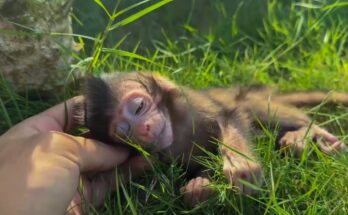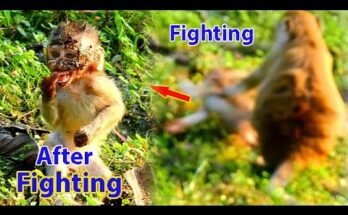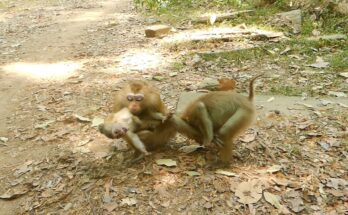The footage titled “Saddest video, monkey king attacks baby monkeys” hits you in the chest from the first frame — a bright, ordinary morning in the trees, birds chirping, sunlight spilling through leaves… and then sudden, shocking chaos. What begins as a peaceful family scene quickly spirals into something heartbreaking: an adult male — the dominant “king” of the troop — turns aggressive, isolating and striking out at the smallest, most vulnerable members. The contrast between the innocence of the infants and the fury of the powerful adult makes the whole scene almost unbearable to watch.
At the center of the clip are the baby monkeys: tiny, wide-eyed, clinging to mothers or to branches, their small bodies trembling. They are barefoot and fragile, their faces a mix of confusion and fear. The “king” moves with confident, terrifying force — chest puffed, eyes flashing — asserting dominance with violent gestures that seem almost ritualized. He lunges once, twice; a baby is shoved, tumbling down a low branch. Mothers scramble, vocalizing sharp, frantic alarm calls, rushing to retrieve their young. The video captures both the raw physicality and the emotional fallout: frantic mothers, the herd’s uneasy silence, and the babies’ plaintive cries that pierce through the forest sounds.
What makes the footage especially wrenching is how human the reactions feel. You can see a mother’s desperate attempt to shield her infant, the way older siblings circle protectively, and the terrified bewilderment on the babies’ faces as they try to understand why the one who should guard them is the one attacking. For viewers, it triggers a mixture of sorrow and helpless rage — sorrow for the injured and frightened, rage at the unrepentant aggression. It’s hard not to imagine being there, to wish you could step in.
The video also raises complicated questions about wild behavior and survival. Dominance displays, infanticide, and aggressive expulsions can be part of primate social dynamics — brutal but often rooted in reproductive competition, resource stress, or social instability. The camera doesn’t explain motive; it only shows consequence. That ambiguity makes the clip more haunting. Without context, the scene reads as pure cruelty, but with context we remember we’re witnessing natural behavior shaped by evolutionary pressures — which doesn’t lessen the emotional impact, but adds layers to our response.
Viewers leave the clip feeling unsettled, not because the spectacle is gory, but because it pulls at something tender inside us: the instinct to protect the young. It’s a reminder that nature can be merciless, and that animals experience complex social tensions that sometimes explode into violence. If there’s a sliver of hope in the footage, it’s the resilience of the mothers and juveniles: they regroup, comfort one another, and the troop’s social bonds show signs of repair even after trauma.
In the end, this is a sad, powerful recording — a raw window into the realities of life in the wild. It prompts empathy, curiosity, and a sobering respect for the fragile balance of animal societies.


